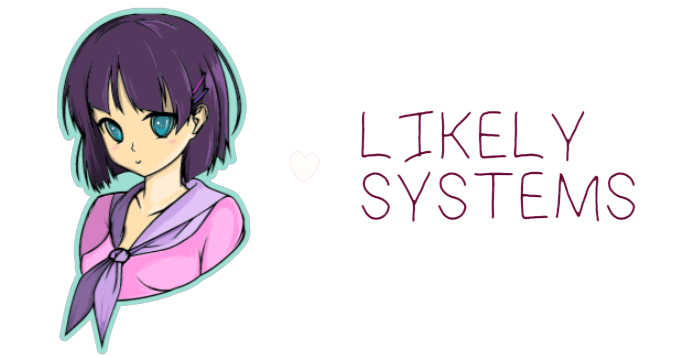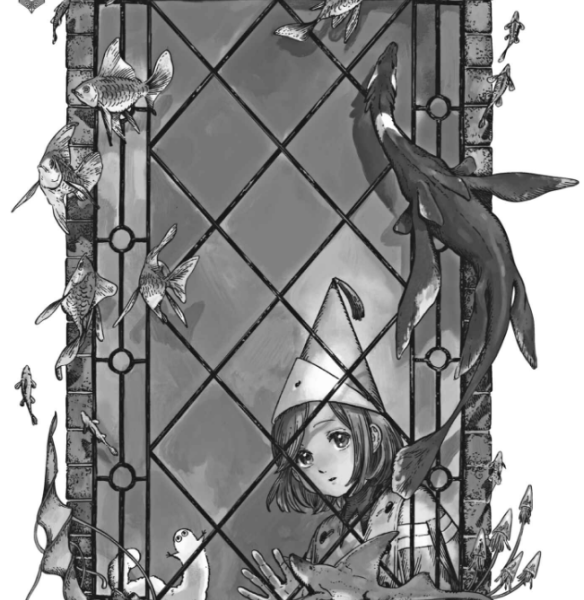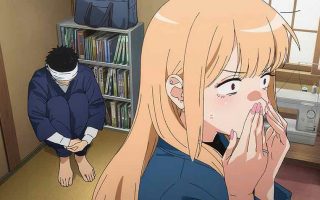The inside cover of Witch Hat Atelier’s sixth volume offers us a beautiful vision of undersea life, all captured through a diamond window pane as Coco stares outwards, hand pressed curiously, almost longingly against the glass. The text echoes both the magnificence of the scene and the necessity of care and confinement, stating: “The Assembly at the bottom of the sea. A bulwark to bestow witches safety, a prison to confine witches daily.” As Witch Hat Atelier has told us time and again, the unbound potential of magic means the most necessary quality of any would-be mage is restraint, an understanding that magic must be handled with care if it is to avoid inflicting more harm than it resolves. Albeit unknowingly, Coco destroyed an entire river ecosystem to save one human life – and to be frank, the fact that she didn’t understand what she was doing is no point in her favor. Humans are capable of unimaginable wonders, but ambition untethered by experience and restraint is frequently a recipe for disaster.
On the other hand, ambition bolstered by the knowledge and practice to control and realize it is the essence of magic, or really any craft of mankind. Counterbalancing the necessary chastisement of Coco is the mastery of mangaka Kamome Shirahama, whose ambition and experience are both clear even in the playful manipulation of paneling offered by this volume’s first page, as a mage of the Assembly’s banner curls gracefully around a panel revealing the Assembly itself. In fields like magic or scientific inquiry, the necessity of practice and restraint is obvious considering the genuinely dangerous consequences of reckless advancement. But in fields like storytelling and visual art, the consequences of ambition without study are just as disastrous, if only in their effect on the coherence, richness, and beauty of your work.
It is practice and study that guides our hands, shaping the raw materials of ambition and ideas into genuine works of art, bolstering our initial concepts with the steady hands and critical eye that can only come from hard-won expertise. To attempt a leap from first idea to finished result without learning the fundamentals of your craft is to disregard all that could possibly instill that idea with emotional substance, aesthetic richness, and personal voice. The consequences might not be as dangerous to bystanders as reckless magical experimentation, but they are no less debilitating to the quality of the work itself.
With our mages’ second trial having resolved into Brimhat-prompted chaos, the girls are swiftly summoned to the Academy, where they are to meet the vaunted “Sage of Instruction” known as Beldarut. Unsurprisingly, Agott is less concerned with the judgment of this sage than with her own standards of behavior, and how she has once again fallen short of them. Reflecting on their calamitous passage through this wizarding trial, her first feeling is one of regret, that she was not able to conquer this passage alone. With her perspective skewed by the expectations of her prestigious wizarding family, Agott can only think in terms of proving them wrong, of demonstrating that she doesn’t need anyone to rise into the upper echelons of magical society. And as usual, it is Coco who punctures this perspective, telling her that “without you, I wouldn’t have made it out safely. You came and saved the day.”
Her words challenge Agott’s perspective on two levels at once. First, there is the challenge to Agott’s perception of her performance, emphasizing that in spite of not succeeding according to her own expectations, her actions nonetheless accomplished something far more important – saving the life of her new friend. That in turn points towards the larger challenge of Coco’s entire philosophy, which positions saving lives and enjoying the beauty of magic as what is truly essential, rather than rising to some arbitrary standard set by people who have never treated Agott kindly. Excellence in any field, when framed as an expectation or obligation, can become a curse that prevents a genuine, personal relationship, a dictate denying the freedom to explore widely and discover what actually inspires you. The bindings that Agott chafes against are simply invisible to Coco – and if they’re meaningless to her friend, does that mean she really has to care about them at all?
The approach to the Academy offers another magnificent example of Shirahama’s paneling, as rectangles are woven above and beneath each other like the wicker strands of a basket, a raucous clutter that presents an overall effect of disorientation and fascination. Through creating an illusion of depth by varying the alignment of panels in this way, Shirahama naturally conveys a sense of Coco’s focus wandering as they approach the undersea structure, here distracted by an encroaching shelf of coral, there drawn back towards her instructor’s sharp words of caution. These tricks of orientation align us with Coco’s perspective in a delightful new way, but it is only through Shirahama’s understanding of panel pacing that the effect does not seem either cluttered or confusing, in spite of breaking some standard rules of drawing the eye across a series of panels.
When people say “you need to know the rules in order to break them,” this is what they mean: without a keen understanding of why aesthetic conventions exist in the first place, efforts to deviate from them will only confuse and distance your audience, rather than enriching their engagement with the text like this. Such mastery similarly demands understanding when less is more, such as in this fairly traditional page. The thicker gutter between the third and fourth panel conveys a natural sense of time’s passage, while the smaller fourth panel acts almost as an establishing shot, conveying a small yet active action in order to draw us back into the drama. A true master does not try to impress with a new bauble at every opportunity; they understand that in order for their wonders to truly stand out, they must exist within a steady, reliable framework that is so skillfully executed it feels almost invisible.
Just as mages must practice care and consideration in applying their talents, so must artists and storytellers practice restraint in how they apply their passions and talents, constraining the fullness of their abilities to what actually fits and facilitates the work at hand. Novices in such fields often want to make each paragraph or panel the most that they have ever created, perpetually one-upping themselves, and thereby abandoning such key virtues as moderation of dramatic tempo, direction of the audience’s attention, and purposeful variation in aesthetic complexity or style. Masters proceed more like Olrugio, who is quick to instruct Coco on when a situation calls for magical restraint.
To take another example, consider Tetia’s loosely drawn map of their new accommodations. Through this simplified diagram, Shirahama demonstrates that in spite of her clear mastery of embellished tapestry-style splendor, she understands that what is most important about this image is that it conveys its layout with clarity, and that it echoes the style of its creator Tetia. Not every image should be adorned with infinite detail, not every character should speak with florid prose, and not every vista should be explicated through ponderous worldbuilding; just like engineers, artists must understand precisely how much they can remove while still maintaining the design of the whole, and seek to match every word or brush stroke to a work’s larger purpose.
Leading Coco through the alleys of the Academy, Tetia happily explains how many witches are born and raised right here in the sanctum, offering fanciful exposition without derailing the momentum of their larger objective. Worldbuilding falls directly under that umbrella of “just because you can illustrate further mastery doesn’t mean that illustration falls within the needs of the work itself,” and is in fact frequently one of the biggest offenders when it comes to writers sabotaging their own works. Be wary of letting your passion for one aspect of storytelling overwhelm your ability to create a thematically coherent, propulsive, and emotionally resonant drama; if you truly wish to reach people with your art, you must harness your own passions effectively, and not let one fascination undercut the structure and beauty of the whole.
Of course, a mage as accustomed to mastery and hungry for novelty as Beldarut might argue that every moment could indeed use more fantastical baubles. The Sage of Instruction’s introduction is delightful; after Olrugio dashes the sage’s smoke illusion, he descends upon a floating chair-mount with cloven hooves, a magical flourish that accommodates his disability without verging into the trite, alienating “in a magically empowered world, all disabled people would be ‘fixed’ and adjusted to the norm.” Through the combination of this world’s laudable reticence to dive into human experimentation and the retroactively obvious flourish of this enchanted walking chair, Shirohama challenges the dehumanizing worldbuilding assumptions of so much fantasy literature, and earnestly grapples with the question of how disabilities might be accounted for in a realm where magic exists, but is not automatically framed as the solution to everything.
Beldarut’s accommodations are of a kind with all of Witch Hat Atelier’s inventions and investigations; magic is interesting, but earnest thought and consideration are what is truly most valuable. What’s more, Beldarut’s circumstances aren’t unduly remarked upon; they are simply the assumed solution within Shirahama’s thoughtfully constructed world, and are in no way reflected by his personality. Beldarut is playful, exuberant, and a little bit childish – he is a character like any other, not a lesson or example. The awkward reflection of isolating characters due to disability is deifying their ability to overcome it; Shirahama knows better than to do that, and thus Beldarut is neither better nor worse than anyone else, he is simply Beldarut. Smiling at our bewildered young mages, he offers them a replacement test as whimsical as the man himself: simply surprise him with their magic at any point in the next three days, and they succeed.
Beldarut’s request emphasizes the cruciality of seeking the new, of forever challenging yourself and finding new horizons for exploration and discovery. His task is really quite self-serving – he wants the girls to surprise him not because he thinks that’s a proper challenge, but because he wants to be surprised, to be delighted and inspired by the ideas of the next generation. He is a true seeker, a master of his craft who is far from content simply sitting on his mastery, or worse, hoarding and lording that mastery over others. The greatest artists and craftsmen can find inspiration in anything, and are in a perpetual, restless search for their next source of inspiration, the next creator who dazzles them with the unique alchemy of their expertise and life experience.
Audiences often fault artists for deviating from the style of creations that first attracted them, but it is the nature of a great artist or craftsman to be perpetually unsatisfied, to always seek new realms for exploration, and to be humble in their appreciation for the magic and genius around them. Absolute mastery is not achievable, perfection is a fantasy, and study is not something to be completed or “won.” To sit comfortably on your prior achievements is only to stagnate; great artists savor the fact that there is always more to experience and integrate, and journey to the end of their lives perpetually marveling at how much more there is to learn. Though stable works mark their passage, the fundamental nature of an artist is transient – they are always suspended between their past glories and future ambitions, each new work marking a step along that journey.
Shirahama’s own work embodies this spirit of discovery, as she perpetually strives to find fresh nuances in the dramatic and aesthetic impact of variations in form and paneling. Our introduction to the girls spying on Beldarut involves a new variation on a favorite trick, as she once again employs tall vertical panels as both establishing shots and bookends of the active drama. She has in the past used them to mirror the effect of actual window shutters, but here she treats them as extensions of Beldarut’s root-filled chamber, as if the girls are literally hiding behind them while planning their magical surprise. Perhaps a bit ostentatious, yes, but entirely in keeping with her playful understanding of comic storytelling, and desire to maintain a conversation regarding the relationship between an object’s crafted form and essence.
Understanding the mechanics of your craft doesn’t just allow you to realize the ideas you already possess, it informs your understanding of what ideas are possible or worth pursuing, inspiring you through the joy of discovering how new technical faculties might facilitate new forms of expression. Like a musician exploring new scales and thereby finding inspiration for their next great work, or an author diving into a new genre and realizing how it might inform their own stories, practice and discovery are not just worthwhile for their own sake, they are the fuel required to stimulate artists and craftsman, steer them in new directions and carry them to new heights.
Of course, scaling such heights demands a certain confidence in the base merit of your perspective and proficiency, as well as the freedom to experiment and fail without fear of terrible consequences. If you are afraid of producing anything short of perfection on your first try, it is easy for that essential joy of discovery to fade, replaced by only a desperation not to disappoint. So it went for Agott, who a local mage named Rolga informs Coco “stole someone else’s magic and tried to pass it off as her own,” the offense that apparently led to her banishment from her distinguished family. Though it is unclear if Agott truly committed this crime, it would be perfectly in keeping with her journey so far, as someone who’s come to see mastery not as a journey of discovery, but as an arbitrary hurdle to be punished for not effortlessly achieving.
As we’ve seen previously, Agott has been taught to put the cart before the horse – not to study magic and make her own discoveries purely for the love of doing so, but only in order to mollify parents and overseers who wish her to be someone different from who she is. When you are attempting to demonstrate mastery only to please others, it of course matters little if you impress with your own magic or a stolen recipe. But to actual artists and craftsmen, such a display is meaningless, because it does not reflect the study, labor, and discovery you underwent in order to arrive at that final result. The final result is merely an after-effect of the process of creation – it is the process itself that is most crucial, the field of conflict and curiosity where your limits are tested and horizons broadened.
That Agott would steal the magic of another demonstrates how her family’s expectations warped and poisoned her ambitions and fundamental perspective on magic; rather than pursuing study and creation freely, and allowing herself the room to experiment and even fail, she was forced to present a vision of unimpeachable strength right from the beginning, and thus copied another rather than risk failure on her own strength. Her failure is the same failure embodied by AI art, a desire to divorce the “output” of a finished work from the input of study, consideration, imagination, and craft. Such creations are devoid of the human spark, grotesque amalgams of disparate proficiencies. In contrast, every personally crafted piece of art is a snapshot of one moment in a creator’s journey, a human footprint elevated by its positioning beyond the journey they’ve taken so far, and before the journey continuing ahead.
Still, even if such a failure falls perfectly in line with Agott’s sad history, Coco is certain she did not steal her magic. Skillful paneling leads us through this interaction, as Agott first internalizes Coco’s faith in her, and then reaffirms her own fatalistic perspective. In the first panel, the sharp closeup emphasizes Agott’s vulnerability in this moment, an unguarded expression matching the closeness of the frame to create a sensation of unexpected intimacy. Then the frame pulls sharply back for the followup, emphasizing Agott’s sense of isolation through the overbearing negative space surrounding her. It is these small tricks of purposeful staging that create profound emotional effects – simply expressing “competency” is not enough, you must design with purpose. That is the lesson Olrugio attempts to impart, when he informs his young students that you must first study the contours of your objective if you wish to create something of holistic substance. Creativity and individual brilliance are lovely, but it is only through harnessing your ideas and proficiencies to a clear purpose that you will make others fully appreciate your work and feelings.
Agott initially refuses to accept collaboration with her fellow apprentices, mired as she is in this perspective of the test as an imposition, a battlefield where she might refute the accusations of all those who scorned and abandoned her. But Coco has no ego or anxieties about performing everything herself – she readily admits that she’s not the best at writing flawless glyphs, and actually desires the feedback and criticism of others to improve her own work. What’s more, she specifically phrases this request in terms of “planning together will be more fun,” a framing that feels utterly alien to Agott. Having fun taking a test?
Agott’s family have done the cruelest thing they could to her: they have stolen her earnest love of study, experimentation, and discovery, replacing it with a desperate fear of not living up to some predetermined example. Such an attitude will never result in your best, most personalized and creative works – it is only through striving along your own paths, embracing complications and failures as part of the process, that you might find your passions and proficiencies on your own terms. Mastery of a craft is not a test with a single right answer – it is a process of expanding the self, and the only way to “fail” is to not embrace the opportunity to discover what you are truly capable of.
“Instead of proving myself, I’ve got a client to satisfy, huh?” Taking her desperate pride out of the equation lessens the load on Agott, shifting her from the mindset of “my every work has to be a pure demonstration of my competency, of the fact that my family was wrong about me.” Her ego does not matter here – working with collaborators is fine, because the intent is not to prove herself worthy, but to make Beldarut happy. Understand the nature of your objective, find joy in the process, and do not let success or failure define you – all key lessons for arriving at a healthy relationship with your work, lest you risk burning out or stalling at the starting line due to your fear of anything short of perfection on the first try. Standing beside her friends, Agott signals her acceptance of this healthier mindset with a defiant war cry, declaring that “whatever happens, happens!”
The “surprising magic” they eventually concoct is not some grand revelation, but merely the harnessing and collaboration of their previously mastered talents, instilled with the whimsical wonder of their personalities, and tethered to a keen understanding of what exactly they are pursuing. Beldarut did not wish to see some individual form of imposing magic he’d never seen before – he wished to be taken on a journey, to be delighted by the wonder and mystery of their imaginations and magical proficiencies working in concert. By embracing the specific contours of the assignment, our young mages were able to find the space within those contours where their own personalities and specialties shined. And as their construction unexpectedly births a rainbow at the bottom of the sea, Coco’s wonder demonstrates the blessed fruits of this process – oftentimes, when you are creating diligently and collaborating well with others, you will ultimately surprise yourself with the magic of what you’ve created.
This article was made possible by reader support. Thank you all for all that you do.




